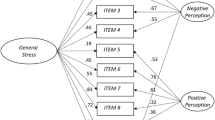Abstract
The relation of perceived stress and psychosocial dysfunction was examined in two clinical samples identifying stress as a personal problem. Perceived stress was significantly correlated with self-reported negative affect and physical symptoms. Negative and total major life event scores also were significantly correlated with self-reported negative affect and physical symptoms. However, the perceived stress scale and the life events measures were moderately correlated, indicating that the two scales assess different features of the stress experience. A major finding of this study was that perceived stress scores were significantly correlated with affective and physical symptoms even after the variance associated with life events had been partialed out.
Similar content being viewed by others
References
Baum, A., Davidson, L. M., Singer, J. E., & Street, S. W. (1987). Stress as a psychophysiological process. In A. Baum & J. E. Singer (Eds.),Handbook of psychology and health (Vol. 5) (pp. 1–24). Hillsdale, NJ: Erlbaum.
Brown, G. W. (1989). Life events and measurement. In G. W. Brown & T. O. Harris (Eds.),Life events and illness (pp. 3–45). New York: Guilford.
Brown, G. W., & Harris, T. O. (1978).Social origins of depression: A study of psychiatric disorder in women. New York: Free Press.
Brown, G. W., & Harris, T. O. (Eds.) (1989).Life events and illness. New York: Guilford.
Cohen, S., & Hoberman, H. (1983). Positive events and social supports as buffers of life stress.Journal of Applied Social Psychology, 12, 99–125.
Cohen, S., & Williamson, G. M. (1988). Perceived stress in a probability sample of the United States. In S. Spacapan & S. Oskamp (Eds.),The social psychology of health (pp. 31–67). Newbury Park, CA: Sage.
Cohen, S., Kamarck, T., & Mermelstein, R. (1983). A global measure of perceived stress.Journal of Health and Social Behavior, 24, 385–396.
Dohrenwend, B. S., & Dohrenwend, B. P. (1974). Overview and prospects for research on stressful life events. In B. S. Dohrenwend & B. P. Dohrenwend (Eds.),Stressful life events: Their nature and effects (pp. 313–331). New York: Wiley.
Dohrenwend, B. S., & Dohrenwend, B. P. (1978). Some issues in research on stressful life events.Journal of Nervous and Mental Disease, 166, 7–15.
Dohrenwend, B. S., & Martin, J. L. (1979). Personal versus situational determinants of anticipation and control of the occurrence of stressful life events.American Journal of Community Psychology, 7, 453–468.
Dohrenwend, B. P., & Shrout, PP. E. (1985). “Hassles” in the conceptualization and measurement of life stress variables.American Psychologist, 40, 780–785.
Dohrenwend, B. S., Dohrenwend, B. P., Dodson, M., & Shrout, P. E. (1984). Symptoms, hassles, social supports, and life events: Problems of confounded measures.Journal of Abnormal Psychology, 93, 222–230.
Gore, S. (1978). The effect of social support in moderating the health consequences of unemployment.Journal of Health and Social Behavior, 19, 157–165.
Holmes, T. H., & Rahe, R. H. (1967). The social readjustment rating scale.Journal of Psychosomatic Research, 11, 213–218.
Lazarus, R. S. (1984). Puzzles in the study of daily hassles.Journal of Behavioral Medicine, 7, 375–389.
Lazarus, R. S., & Folkman, S. (1984).Stress, appraisal, and coping. New York: Springer.
Lazarus, R. S., DeLongis, A., Folkman, S., & Gruen, R. (1985). Stress and adaptational outcome: The problem of confounded measures.American Psychologist, 40, 770–779.
Paterson, R. J., & Neufeld, R. W. J. (1987). Clear danger: Situational determinants of the appraisal of threat.Psychological Bulletin, 101, 404–416.
Paykel, E. S. (1982). Life events and early environment. In E. S. Paykel (Ed.),Handbook of affective disorders (pp. 146–161). New York: Guilford.
Rabkin, J. G., & Struening, E. L. (1976). Life events, stress, and illness.Science, 194, 1013–1020.
Rowlison, R. T., & Felner, R. D. (1980). Major life events, hassles, and adaptation in adolescence: Confounding in the conceptualization and measurement of life stress and adjustment revisited.Journal of Personality and Social Psychology, 55, 432–444.
Sarason, I. G., Johnson, J. H., & Siegel, J. M. (1978). Assessing the impact of life changes: Development of the life experiences survey.Journal of Consulting and Clinical Psychology, 46, 932–946.
Speilberger, C. D., Gorsuch, R. L., Luschene, R., Vagg, P. R., & Jacobs, G. A. (1983).Manual for the state-trait anxiety inventory (Form Y). Palo Alto, CA: Consulting Psychologists Press.
Stroebe, W., Storebe, M. S., Gergen, K. J., & Gergen, M. (1982). The effects of bereavement on mortality: A social psychological analysis. In J. R. Eiser (Ed.),Social psychology and behavioral medicine (pp. 527–561). New York: Wiley.
Vinokur, A., & Selzer, M. L. (1975). Desirable versus undesirable life events: Their relationship to stress and mental distress.Journal of Personality and Social Psychology, 32, 329–337.
Zautra, A. J., & Reich, J. W. (1983). Life events and perceptions of life quality: Developments in a two-factor approach.Journal of Community Psychology.11, 121–132.
Zimmerman, M., & Coryell, W. (1987). The inventory to diagnose depression (IDD): A self-report scale to diagnose depression.Journal of Consulting and Clinical Psychology, 55, 55–59.
Zimmerman, M., Coryell, W., Corenthal, C., & Wilson, S. (1986). A self-report scale to diagnose major depressive disorder.Archives of General Psychiatry, 43, 1076–1081.
Author information
Authors and Affiliations
Rights and permissions
About this article
Cite this article
Pbert, L., Doerfler, L.A. & DeCosimo, D. An evaluation of the perceived stress scale in two clinical populations. J Psychopathol Behav Assess 14, 363–375 (1992). https://doi.org/10.1007/BF00960780
Accepted:
Issue Date:
DOI: https://doi.org/10.1007/BF00960780




